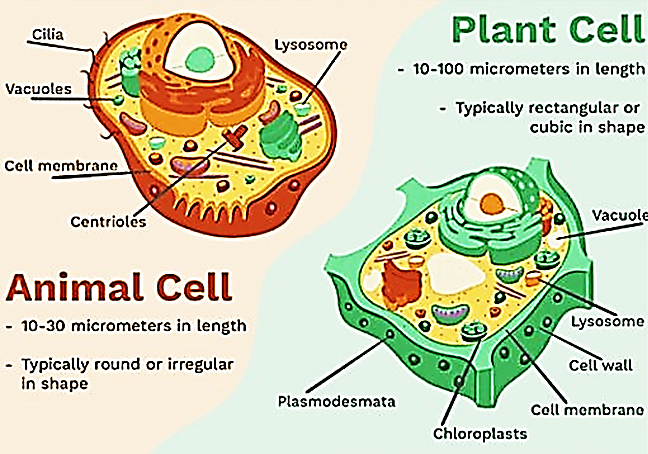Question
Question: Make a comparison and write down ways in which plant cells are different from animal cells...
Make a comparison and write down ways in which plant cells are different from animal cells
Solution
Cells differ in their structures based on their function and complex organization of an organism. The plant needs cells with a larger surface area for the absorption of light for photosynthesis. Animals need extracellular structures to digest waste and lack coloring pigments.
Complete answer:
Cells are a very small but complex structure. They form the basic structural and functional unit of an organism.
Table 1: Comparison between plant and animal cell
| Features | Animal cell | Plant cell |
|---|---|---|
| Size | Small | Large |
| Shape | Irregular shape | Square or rectangular shape |
| Cell wall | Only consist of the cell membrane, the cell wall is absent | Both the cell wall and cell membrane are present. The cell membrane is made of cellulose |
| Plastids | Absent | Present; like chloroplast containing chlorophyll for photosynthesis and chloroplast containing carotenoids for coloration of fruits and flowers. |
| Lysosomes | Present in large numbers and used in the digestion of waste materials. | Either absent or very few in number. |
| Centrosomes | Centrosomes give rise to centrioles that form spindle fibers during mitosis. | Absent, cells divide by cell plate formation. |
| Location of nucleus | Center | Peripheral |
| Vacuoles | Smaller in size | Larger in size |
| Mitochondria | More in number | Less in number |
| Golgi body | Single Golgi body present near the nucleus | Many subunits of Golgi bodies known as dictyosomes are present |
| Food storage | Food stored as Glycogen | Food stored as Starch |
| Plasmodesmata | Absent | Present |
Figure 1: Difference between plant and animal cells

Additional Information:
1. The study of the structure of cells is called Cytology.
2. MJ. Schleiden (1838), a German botanist and T. Schwann (1839), a German zoologist together formulated the cell theory or cell doctrine. According to which the bodies of animals and plants are composed of cells.
3. Schwann proposed that the presence of a cell wall is a unique character of plant cells.
4. Instruments that scientists discovered for knowing about plant cells and animal cells are the compound light microscope, electron microscope, interference microscope, fluorescence microscope, x-ray microscope, and ultra-centrifuge microscope.
Note: Both animal and plant cells are eukaryotic cells having a true nucleus, enclosed by a nuclear membrane. Although animal and plant cells differ in some characters they have a lot of common characters too. For example, they both undergo cellular respiration to meet energy requirements, they undergo reproduction through cell division including both mitosis and meiosis, and contain many similar cell organelles like Nucleus, endoplasmic reticulum, ribosomes, etc.
